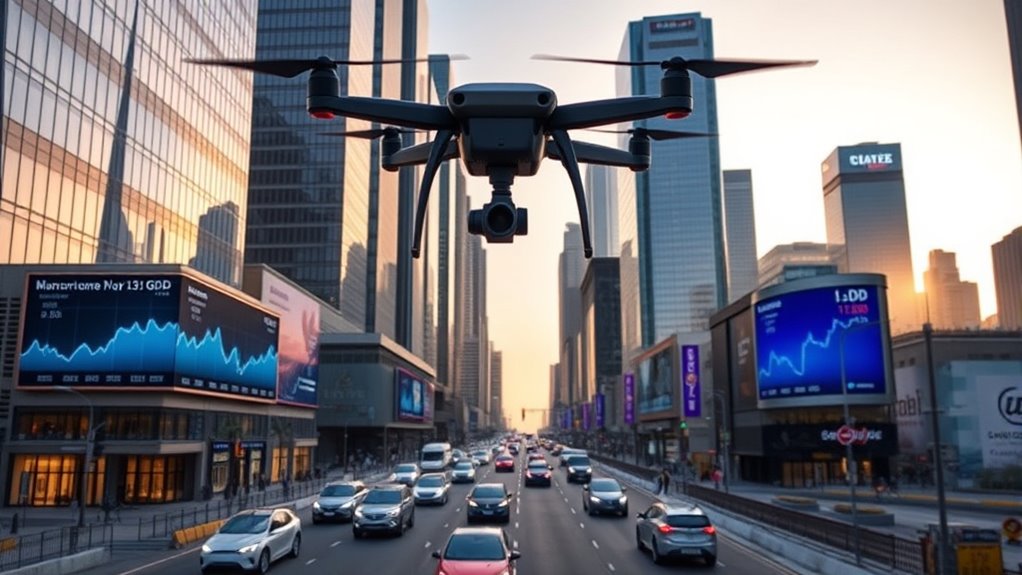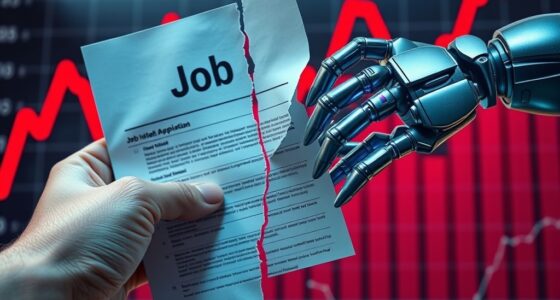As automation transforms industries and boosts productivity, traditional GDP metrics struggle to capture this new economic landscape. With tasks being automated, digital goods growing, and AI creating both opportunities and disruptions, the usual measures may underestimate true growth and well-being. You’ll explore how automation impacts employment, industry, and the limitations of our current metrics—plus why rethinking economic success is more necessary than ever. Stay tuned to understand how these changes reshape our economic yardsticks.
Key Takeaways
- Traditional GDP metrics underestimate digital goods, platform economies, and intangible assets increasingly prevalent in automated and digital markets.
- Automation-driven productivity gains may not translate directly into improved well-being or standard of living.
- AI and digitalization complicate measurement by blurring boundaries, making it hard to track cross-border and virtual economic activities.
- Existing indicators lack sensitivity to technological disruptions and new forms of value creation, questioning their relevance.
- Rethinking economic success requires developing new metrics beyond GDP that capture societal well-being and sustainable growth.
The Growing Role of Automation in Economic Output

Automation is transforming economic output by substantially boosting productivity and efficiency across industries. You’ll notice that manual errors decrease, work speeds up, and resources are used more effectively, leading to higher outputs. Companies adopt automation to cut costs on labor and repetitive tasks, which improves profitability. Automated processes deliver consistent quality, reducing waste and enhancing product standards. With routine work automated, employees can focus on creative, strategic tasks, increasing job satisfaction. This shift fuels economic growth, as businesses expand and innovate faster. Additionally, the integration of Kia Tuning modifications exemplifies how industry-specific automation and customization can further optimize performance and competitiveness. Moreover, the rise of specialized water parks demonstrates how targeted automation and design contribute to unique customer experiences and operational efficiency. Overall, automation plays a key role in shaping economic productivity, making industries more competitive and dynamic. Recognizing that industry-specific tuning techniques like Honda Tuning can be enhanced through automation showcases how technological integration further drives industry excellence. Advances in manufacturing automation also enable faster production cycles and better quality control, strengthening industry resilience and adaptability.
Projected Impact of AI on Global and Emerging Economies
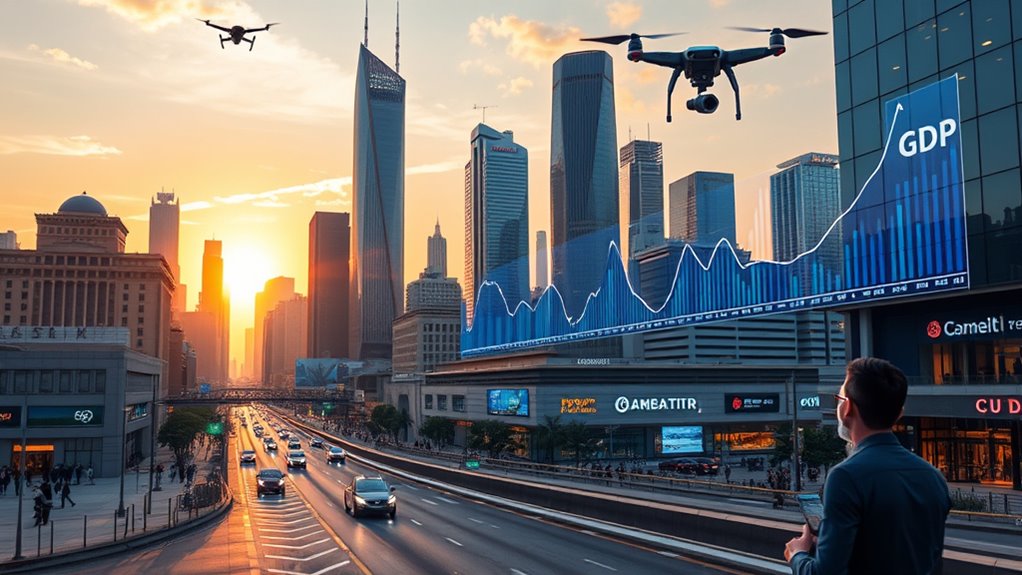
Artificial Intelligence is poised to profoundly reshape global and emerging economies, with projections indicating substantial increases in GDP and productivity. You could see global GDP grow by $7 trillion over ten years, according to Goldman Sachs, or between $17.1 and $25.6 trillion annually, per McKinsey. However, estimates vary, with MIT suggesting a modest 1% boost in the next decade. Regional differences will influence impact, with some areas experiencing more rapid growth. Here’s what to expect:
- AI-driven growth will boost global GDP but vary by region.
- Emerging economies may face integration challenges but could see productivity gains.
- Nearly 40% of jobs worldwide will be affected, impacting developing markets.
- Increased energy demand from AI could raise greenhouse emissions, requiring sustainable solutions.
- The adoption of innovative plant containers like self-watering and waterless planters exemplifies how sustainable technology can be integrated into daily life, paralleling the technological shifts impacting economies.
- As automation accelerates, understanding economic metrics such as GDP becomes even more crucial for policymakers and analysts to gauge true progress and disparities.
- The importance of clear and accurate statistical data is essential to properly assess the effects of automation on economic growth and inequality.
- Additionally, ongoing security concerns related to cyber threats could influence the stability and resilience of a digitally driven economy.
The Relationship Between Automation and Employment Trends
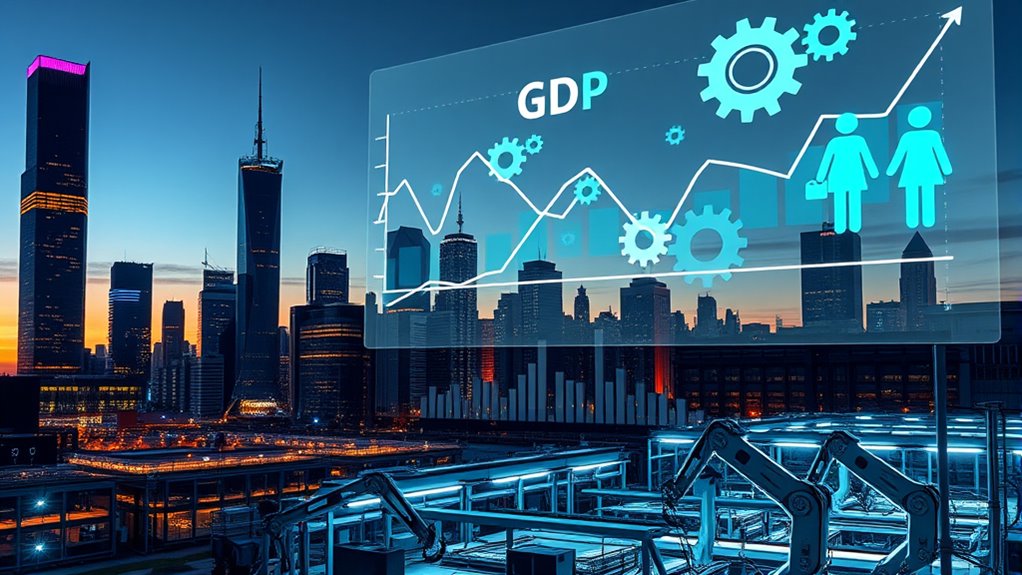
Automation is changing employment patterns, with about 1 in 8 workers at high risk of displacement. While some jobs are vulnerable, others that require human skills are expected to grow, prompting a focus on reskilling efforts. Understanding these shifts helps you see how workforce strategies adapt to the evolving relationship between automation and jobs. Approximately 19.2 million jobs face high or very high automation displacement risk, highlighting the importance of strategic workforce planning. Recognizing technological vulnerabilities in payment systems can help businesses develop more resilient operational strategies, especially when considering the importance of natural materials and craftsmanship in sustainable industries. Additionally, advancements in home theater technology demonstrate how innovation impacts consumer choices and industry trends. As the landscape shifts, prioritizing mental and emotional well-being techniques can also support workers in adapting to these changes and maintaining resilience. For example, understanding freshness indicators can assist businesses and consumers in making smarter decisions about perishable goods, which parallels the need for awareness in workforce health and sustainability.
Automation and Job Displacement
As technological advancements accelerate, many workers face the reality that a significant portion of their jobs may soon be replaced by AI and machines. Currently, about 60% of jobs in advanced economies are at risk of automation, with 300 million jobs potentially lost worldwide. At the same time, 170 million new jobs could be created, but 92 million jobs might disappear, leading to a complex employment landscape. Consider these points:
- Over 14% of workers have already experienced job displacement due to AI.
- 30% of workers fear losing their jobs to AI by 2025.
- Industries like energy and mining face a 46.5% risk of automation by 2030.
- The tech sector saw 136,831 layoffs, with AI accounting for 5% of U.S. job losses in May 2023. Widespread automation could affect 1.2 billion employees
- The potential for automation to influence employment trends underscores the importance of adaptable workforce strategies.
Workforce Reskilling Strategies
The rapid pace of technological change is reshaping the labor market, making workforce reskilling more important than ever. You should prioritize reskilling efforts, as 85% of employers are focusing on this to stay competitive. Digital transformation will redefine business operations by 2030, with 60% of companies expecting significant impacts. AI and automation drive this shift, prompting 86% of employers to emphasize skills in AI and data processing. As demand for tech skills grows, human abilities like creativity and critical thinking remain crucial. Implementing a lifelong learning culture and securing leadership support help sustain reskilling initiatives. Providing continuous AI training not only boosts employee retention—by up to 37%—but also enhances your organization’s market responsiveness and innovation, ensuring you stay ahead amidst ongoing automation. Emphasizing the importance of personality traits can also help tailor reskilling programs to individual strengths and preferences. Recognizing the impact of GDP in the Age of Automation: Does Our Favorite Metric Still Make Sense? emphasizes the need for adaptable workforce strategies in a changing economic landscape. Additionally, regularly reviewing and measuring reskilling outcomes using relevant quality assurance metrics ensures continuous improvement and alignment with organizational goals. Moreover, integrating insights from AI-driven automation can help organizations better identify skills gaps and prioritize training areas effectively.
Employment Pattern Shifts
Technological advancements are reshaping employment patterns by transforming how industries operate and which skills are in demand. You’ll notice some jobs decline while others grow, reflecting automation’s mixed impact. For example:
- Personal financial advisors are expected to grow 17.1% from 2023 to 2033, driven by demand for human counsel.
- Medical transcriptionists and customer service reps will decline by 4.7% and 5%, respectively, due to automation.
- AI boosts demand for computer specialists to build and maintain AI infrastructure.
- Fields like engineering and architecture see productivity gains without significant job losses.
- Understanding the divorce process and navigating legal and emotional considerations are crucial as personal circumstances evolve in response to societal changes.
- The shifting employment landscape underscores the importance of developing adaptability and new skills to stay relevant in the evolving job market.
These trends show that automation doesn’t just eliminate jobs; it shifts demand toward new roles and skills. The labor market is evolving, demanding adaptability and new expertise across sectors.
How Business Process Automation Is Reshaping Productivity
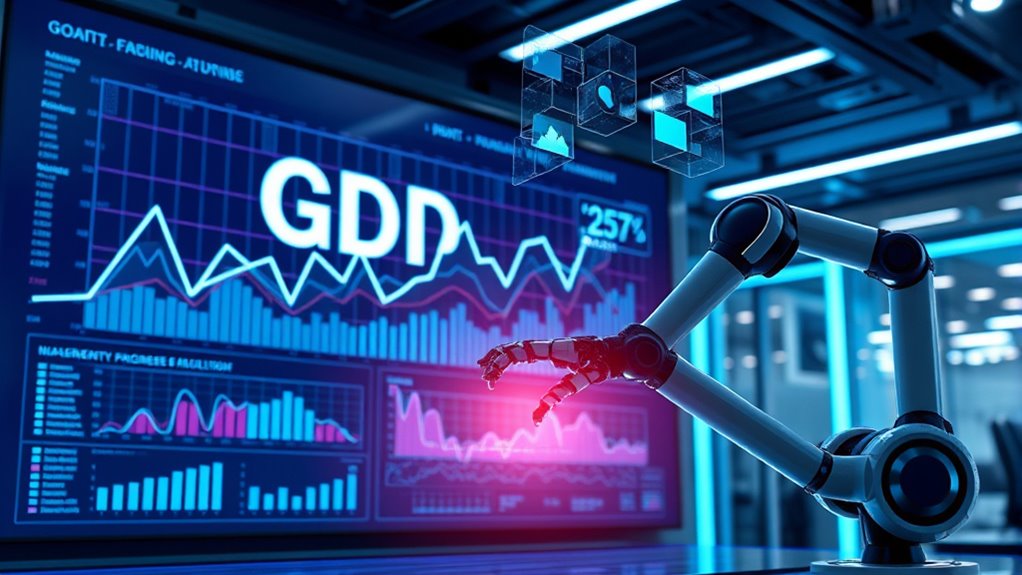
Business process automation boosts productivity by streamlining workflows and cutting down manual tasks, allowing you to focus on strategic priorities. It also saves costs by reducing errors and operational expenses, making processes more efficient. As a result, your organization can deliver faster, higher-quality outputs while reallocating resources more effectively.
Enhancing Workflow Efficiency
As companies embrace automation, they are transforming how work gets done by streamlining repetitive tasks and reducing errors. This shift boosts operational efficiency and speeds up workflows. You’ll see four key impacts:
- Faster completion of tasks, saving valuable time.
- Up to 70% fewer errors, leading to smoother operations.
- Better management of end-to-end processes, reducing bottlenecks.
- Improved work-life balance for employees by eliminating tedious routines.
With nearly 94% of companies performing repetitive tasks, automation’s role in enhancing productivity is clear. As digital transformation continues, automation tools—especially AI and cloud-based platforms—are making workflows more efficient, competitive, and adaptable. This evolution not only increases output but also reshapes how businesses operate daily. The industrial automation market is projected to grow from $147.06B in 2019 to $264.69B in 2026, highlighting the increasing adoption and importance of automation in modern industries.
Cost Savings Strategies
Automation is revolutionizing how companies cut costs and boost efficiency, making it an essential part of modern productivity strategies. With an average ROI of 240%, automation recoups investments within six to nine months and can reduce operational costs by up to 90%. Error reduction of up to 70% minimizes rework expenses, while freeing employees to focus on higher-value tasks. The financial impact is significant, with automation saving 30% on hiring and reducing marketing costs by 12%.
| Benefit | Impact | Example |
|---|---|---|
| Cost Savings | Up to 90% reduction in operational expenses | Automating routine processes |
| ROI | 30-200% within the first year | Quick payback periods |
| Error Reduction | 70% fewer mistakes | Fewer rework costs |
| Employee Productivity | 15-30% efficiency gains | Automating repetitive tasks |
| Market Growth | Automation market projected to $45B by 2032 | Expanding automation adoption |
Challenges in Measuring GDP in a Digitally Automated World

Measuring GDP in a digitally automated world presents significant challenges because traditional accounting frameworks struggle to keep pace with rapid technological changes. You face issues like:
- Digitalization and new service forms—platforms like Airbnb and Uber blur lines in GDP calculation.
- Digital goods and services—free online content and digital bundles aren’t fully captured, underestimating growth.
- International transactions and digital assets—tracking cross-border digital trade and knowledge assets becomes complex.
- Productivity measurement—rising digital productivity sparks questions about existing growth rates.
These challenges make it difficult to accurately reflect the true size and health of the economy. As digital activities evolve quickly, your existing measures often fall short, risking an incomplete economic picture. The production boundary is increasingly blurred by digital activities, making it harder to distinguish what should be counted in GDP from what should be excluded.
Limitations of Traditional Economic Metrics in the Age of AI

Traditional economic metrics face significant limitations in the age of AI because they rely heavily on data quality, transparency, and static models that struggle to keep up with rapid technological advances. AI-driven data collection can introduce errors, while complex models often lack transparency, making it hard to interpret results. Relying on historical data may miss future shifts, and biases in training data can distort forecasts. Additionally, AI’s “black box” nature hampers understanding decision processes. Here’s a snapshot of these challenges:
| Issue | Explanation |
|---|---|
| Data Quality | AI data may be unreliable without validation |
| Transparency | Models lack clarity, complicating interpretation |
| Historical Dependence | Fails to predict sudden economic changes |
| Bias & Errors | Propagates inaccuracies from training data |
| Explainability | Difficult to justify AI-driven insights |
Rethinking Economic Success in a Highly Automated Future

As AI continues to reshape economies, relying solely on conventional measures like GDP to gauge success becomes increasingly insufficient. You need new ways to understand progress in a highly automated future. Consider these points:
- AI is projected to boost global GDP by 7% over a decade, adding around $7 trillion, but growth depends on technological alignment and new goods.
- Automation could lead to superexponential growth, yet productivity increases of 1.5% annually may not reflect true well-being.
- About 25% of labor tasks in advanced economies could be automated, freeing workers for new roles, although inequality might widen.
- Traditional GDP metrics struggle to account for new goods, changing utility, and economic complexity, prompting a need for innovative success indicators.
Frequently Asked Questions
How Will Automation Affect Income Inequality Globally?
You might wonder how automation impacts income inequality worldwide. It tends to widen the gap by displacing less-educated workers and boosting returns for capital owners. As AI automates more complex tasks, high-income workers benefit most, leaving lower-wage earners behind. To address this, policymakers need to implement strategies that promote fair distribution, ensuring automation benefits everyone rather than just the wealthy, or inequality could continue to grow globally.
Can GDP Growth Accurately Reflect Societal Well-Being?
You might think GDP growth perfectly shows societal happiness, but that’s like judging a person’s health by their weight alone. It ignores income gaps, health, education, and environment. So, while your economy might look booming, people’s lives could be worsening. Automation may boost GDP but not necessarily well-being. Truly, relying on GDP as a measure is like reading a book by its cover—misses the story behind the numbers.
What New Metrics Are Needed to Measure Automation’S Impact?
You recognize that traditional metrics fall short in capturing automation’s full impact. To better understand, you need new metrics that track job displacement and creation, measure productivity improvements, and assess income inequality. These indicators help you see how automation affects societal well-being beyond just economic output. By using these, you can develop policies that promote inclusive growth and ensure the benefits of automation reach everyone, not just a select few.
Will Automation Lead to a Universal Job Crisis or New Opportunities?
Automation’s ripple effect is like a tide—some jobs wash away, others emerge like hidden treasures. You might worry about a universal crisis, but remember, every wave creates new opportunities. As routine tasks sink, your skills can rise, transforming challenges into growth. Embrace the shift; it’s not just an end but a dawn for innovation. Your adaptability becomes the compass guiding you through this changing landscape toward new horizons.
How Should Policymakers Adapt to Automation-Driven Economic Changes?
You should adapt your policies to address automation’s impact by updating labor laws, investing in workforce reskilling, and fostering public-private partnerships. Focus on developing skills that complement AI, like creativity and problem-solving, and strengthen social safety nets to support displaced workers. Rethink economic measures like GDP to better reflect automation’s productivity gains, ensuring inclusive growth and fair distribution of benefits across sectors and communities.
Conclusion
As automation transforms economies, it’s clear that traditional GDP metrics may no longer fully capture growth. For instance, studies show that AI could add $15.7 trillion to the global economy by 2030, yet unemployment rates may rise in certain sectors. You’ll need to contemplate new ways of measuring success that reflect digital progress and productivity. Embracing these changes helps you better understand your economy’s true health in this automated age.
